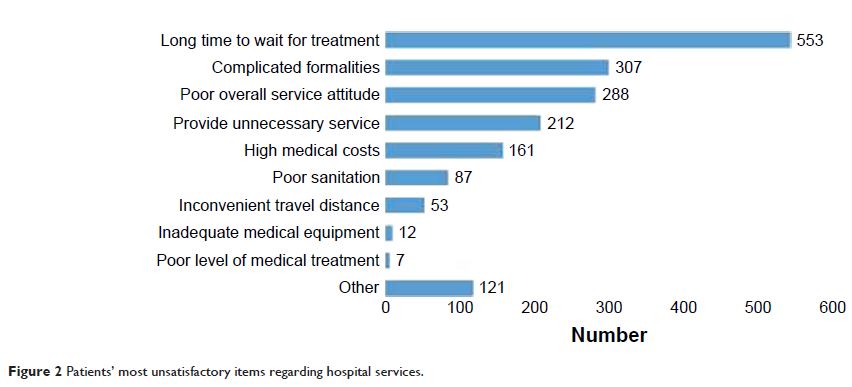108605
论文已发表
注册即可获取德孚的最新动态
IF 收录期刊
- 3.4 Breast Cancer (Dove Med Press)
- 3.2 Clin Epidemiol
- 2.6 Cancer Manag Res
- 2.9 Infect Drug Resist
- 3.7 Clin Interv Aging
- 5.1 Drug Des Dev Ther
- 3.1 Int J Chronic Obstr
- 6.6 Int J Nanomed
- 2.6 Int J Women's Health
- 2.9 Neuropsych Dis Treat
- 2.8 OncoTargets Ther
- 2.0 Patient Prefer Adher
- 2.2 Ther Clin Risk Manag
- 2.5 J Pain Res
- 3.0 Diabet Metab Synd Ob
- 3.2 Psychol Res Behav Ma
- 3.4 Nat Sci Sleep
- 1.8 Pharmgenomics Pers Med
- 2.0 Risk Manag Healthc Policy
- 4.1 J Inflamm Res
- 2.0 Int J Gen Med
- 3.4 J Hepatocell Carcinoma
- 3.0 J Asthma Allergy
- 2.2 Clin Cosmet Investig Dermatol
- 2.4 J Multidiscip Healthc

影响患者对地方病医疗服务满意度的因素:在中国南昌的一项横断面研究
Authors Liu X, Lu H, Wang Y, Wang W, Hou Z, Tan A, Mao Z
Received 4 March 2018
Accepted for publication 25 May 2018
Published 30 July 2018 Volume 2018:12 Pages 1373—1382
DOI https://doi.org/10.2147/PPA.S167244
Checked for plagiarism Yes
Review by Single-blind
Peer reviewers approved by Dr Cristina Weinberg
Peer reviewer comments 2
Editor who approved publication: Dr Naifeng Liu
Purpose: This study aimed to determine the factors that influence patient
satisfaction with ecdemic medical care.
Materials and
methods: Eight hundred and forty-four
face-to-face interviews were conducted between October and November 2017 in two
high-profile hospitals in Nanchang, China. Patient satisfaction was divided
into lowest and highest satisfaction groups according the 80/20 rule.
Demographic factors associated with patient satisfaction were identified by
logistic regression models.
Results: Respondents’ main reasons for choosing a non-local hospital were
“high level of medical treatment” (581/844), “good reputation of the hospital”
(533/844), and “advanced medical equipment” (417/844). The top three items that
dissatisfied the ecdemic patients were “long time to wait for treatment”
(553/844), “complicated formalities” (307/844), and “poor overall service
attitude” (288/844). Fewer female patients (adjusted odds ratio [AOR] =1.47,
95% confidence interval [CI] =1.03–2.11), patients with a family per-capita
monthly income (FPMI) between 3,001 and 5,000 CNY (AOR =1.40, 95% CI
=1.01–2.17), inpatients (AOR =1.46, 95% CI =1.01–2.13), and more patients with
an FPMI >7,000 CNY (AOR =0.43, 95% CI =0.20–0.92) were detected in the
lowest satisfaction group. Fewer patients with an associate’s or bachelor’s
degree (AOR =2.40, 95% CI =1.37–4.20) and patients with an FPMI >7,000 CNY
(AOR =3.02, 95% CI =1.10–8.33) were detected in the highest satisfaction group.
Moreover, more inpatients (AOR =0.70, 95% CI =0.54–0.97) and those aged 46–65
years (AOR =0.63, 95% CI =0.33–0.98) were detected in the highest satisfaction
group.
Conclusion: Findings suggested that managers of the medical facilities should
note the importance of increasing their publicity through a rapidly developing
media, as well as the necessity of creating a more patient-friendly medical
care experience. Hospitals should also focus on the medical care experience of
patients with relatively lower and higher income levels, male ecdemic patients,
and ecdemic outpatients.
Keywords: patient satisfaction, ecdemic medical care, ecdemic patients, the
80/20 rule
